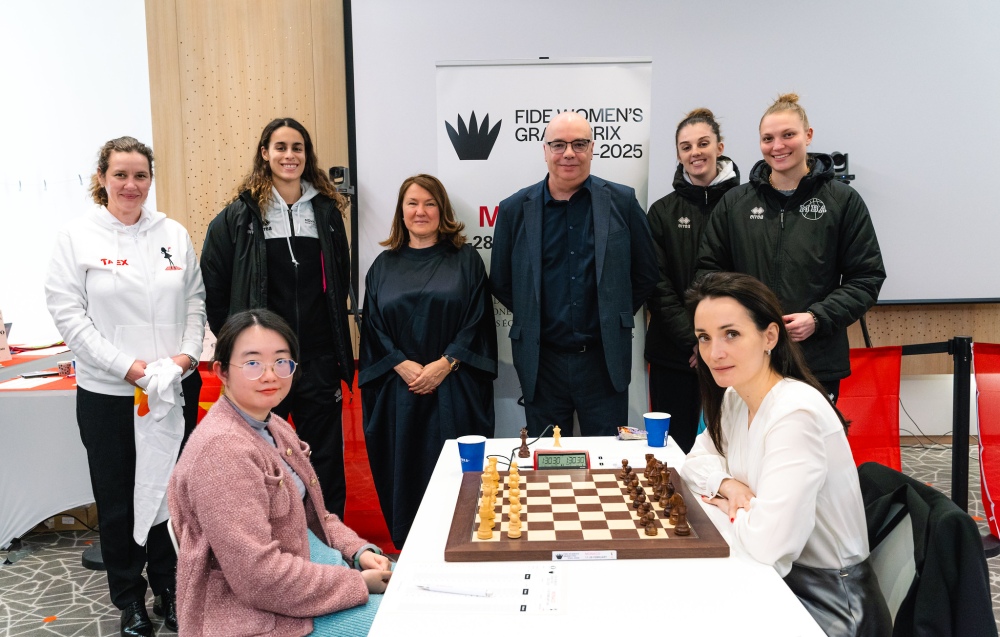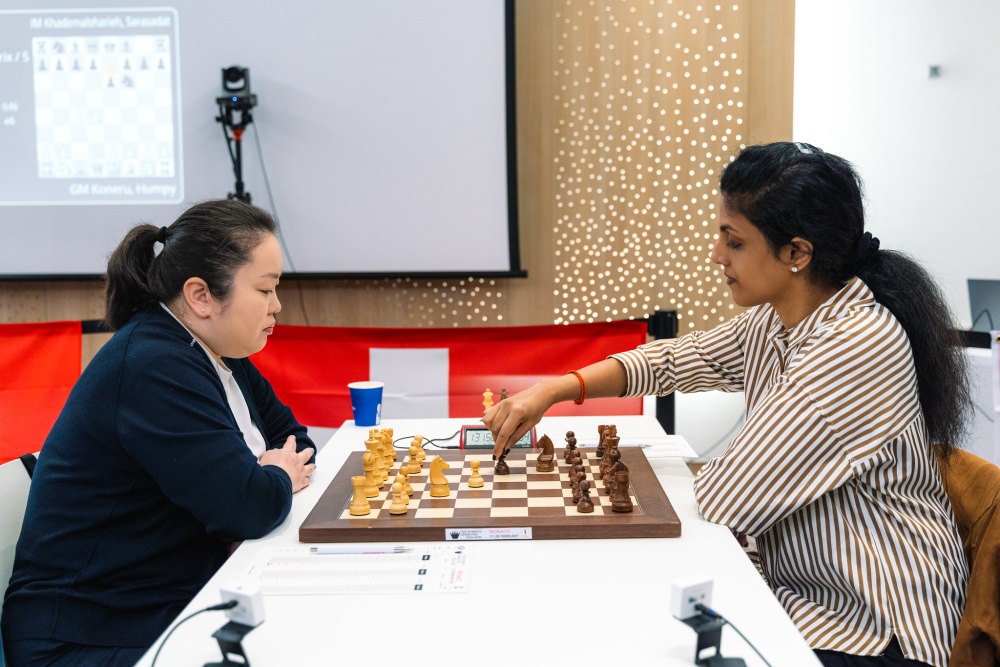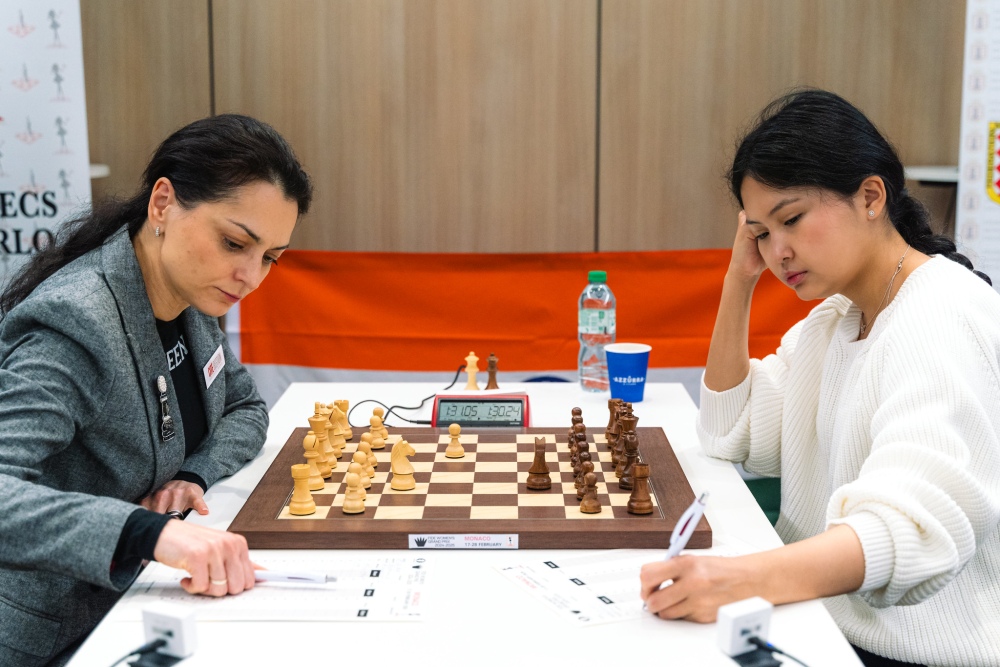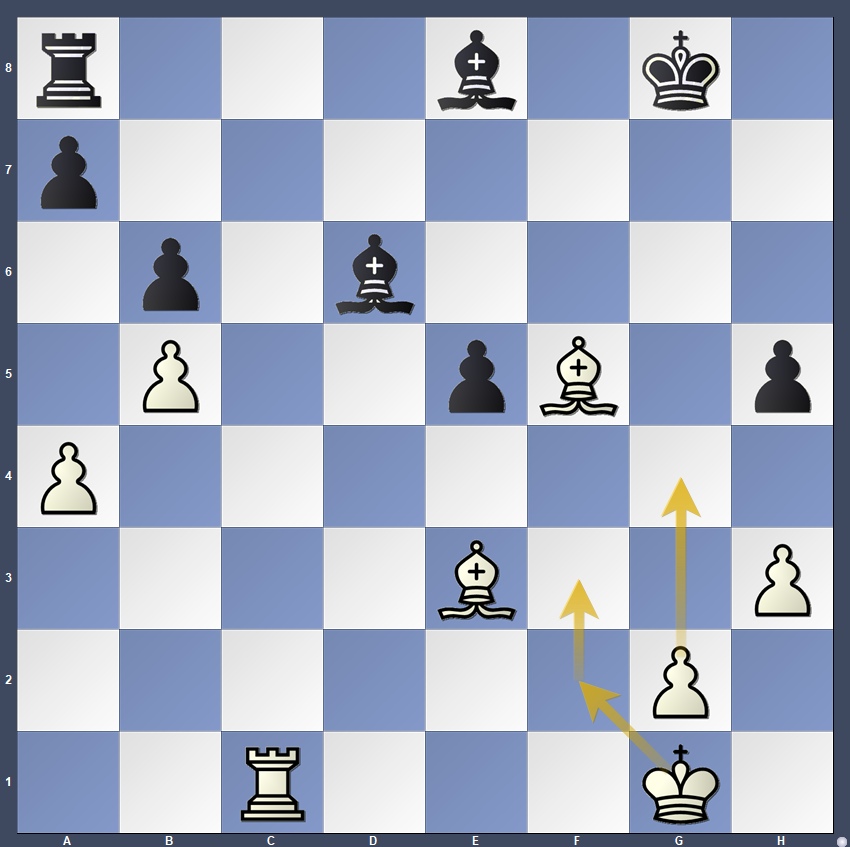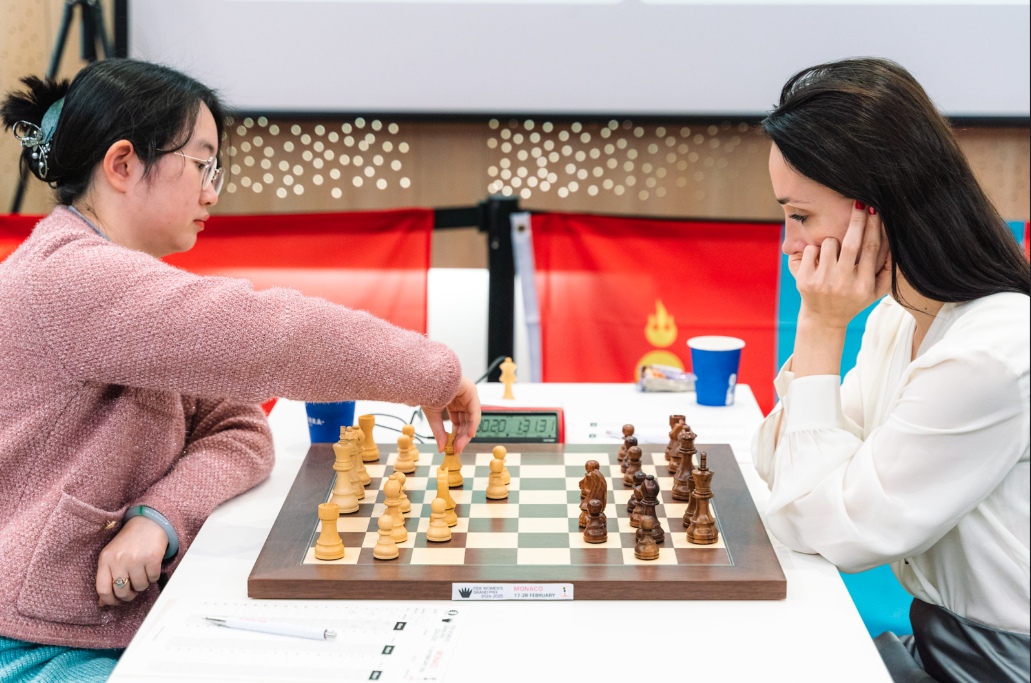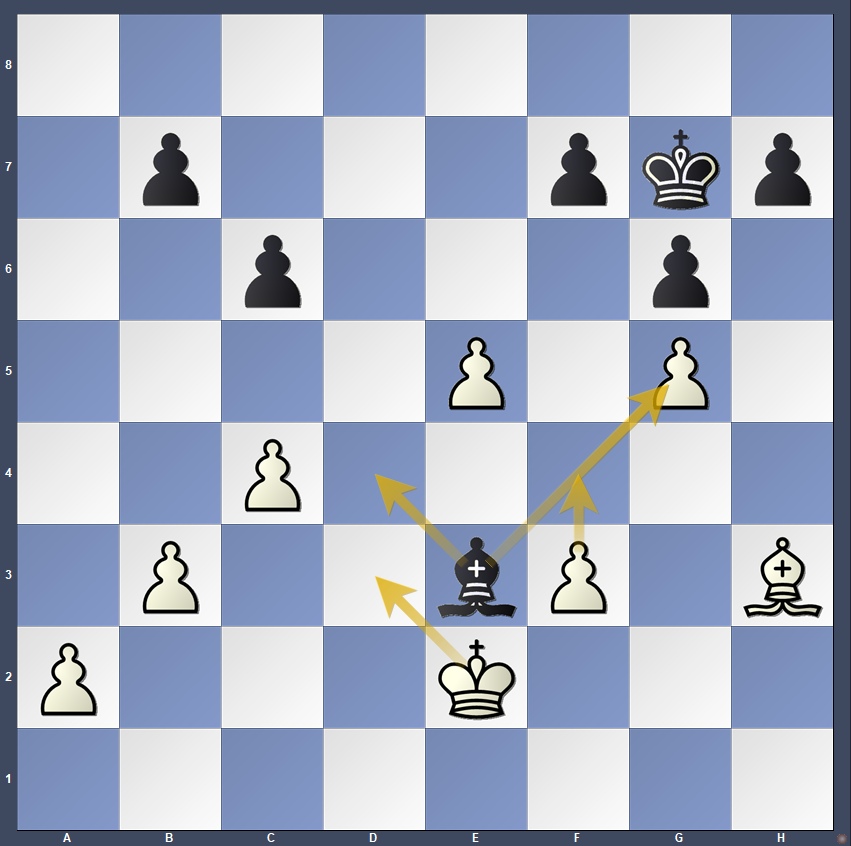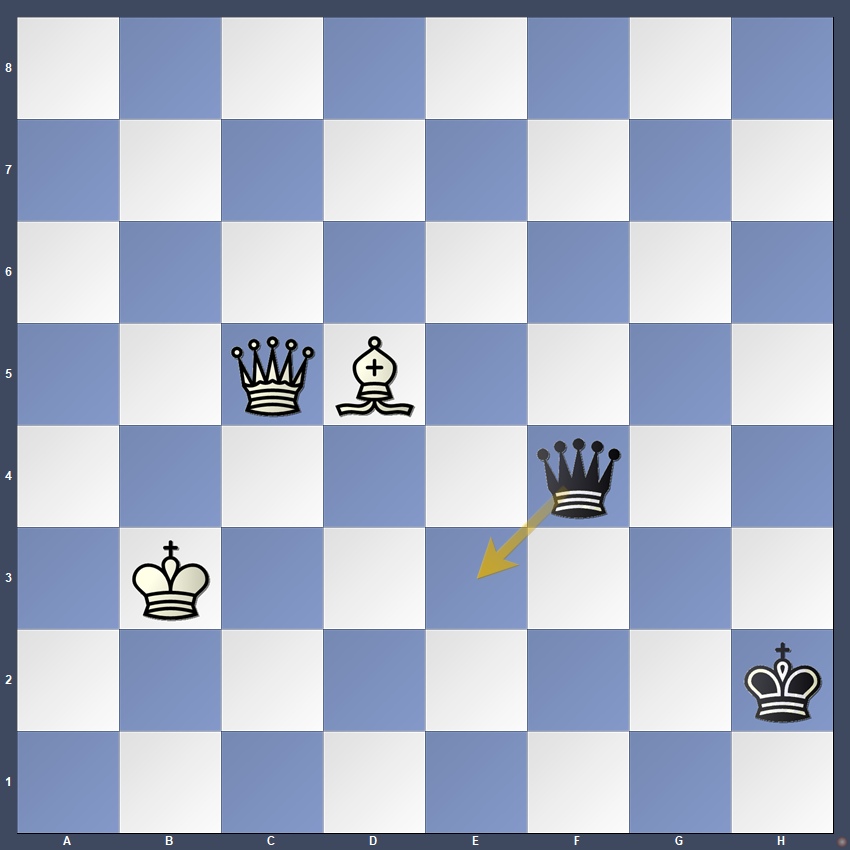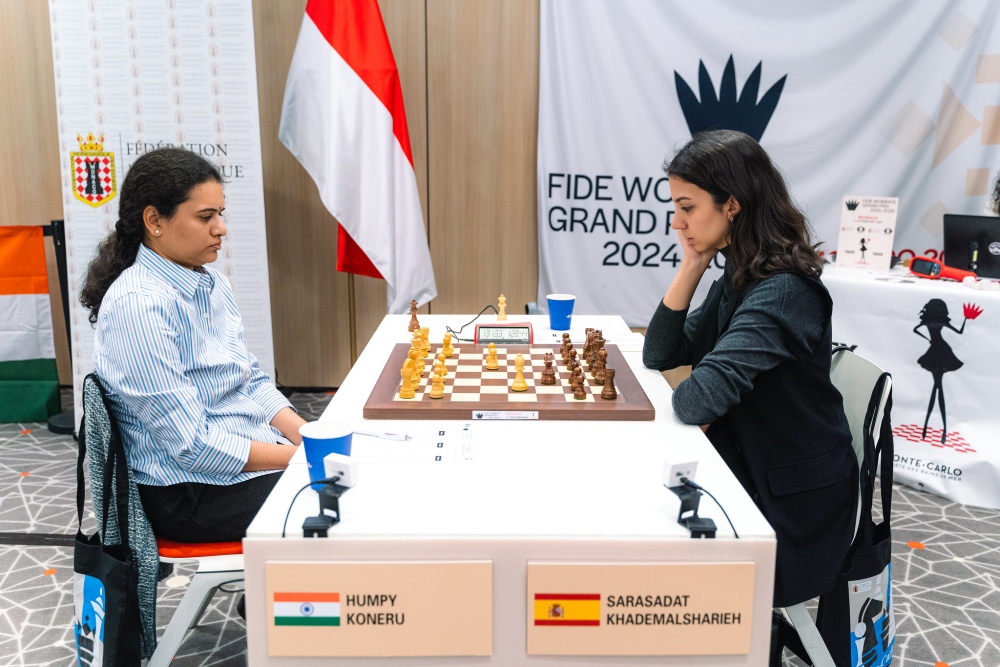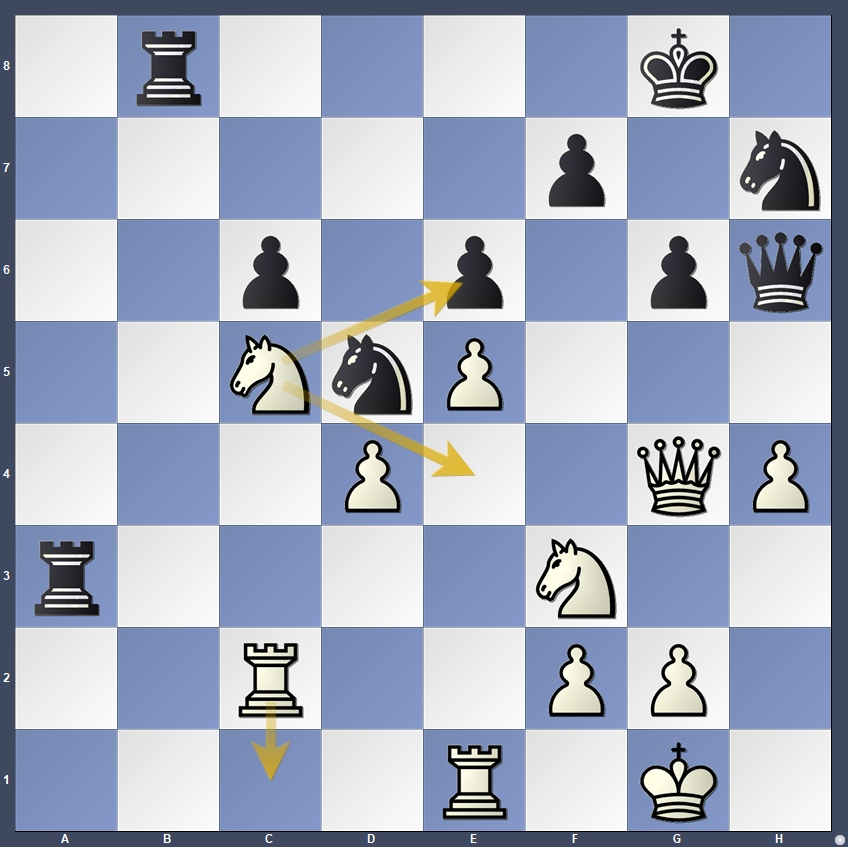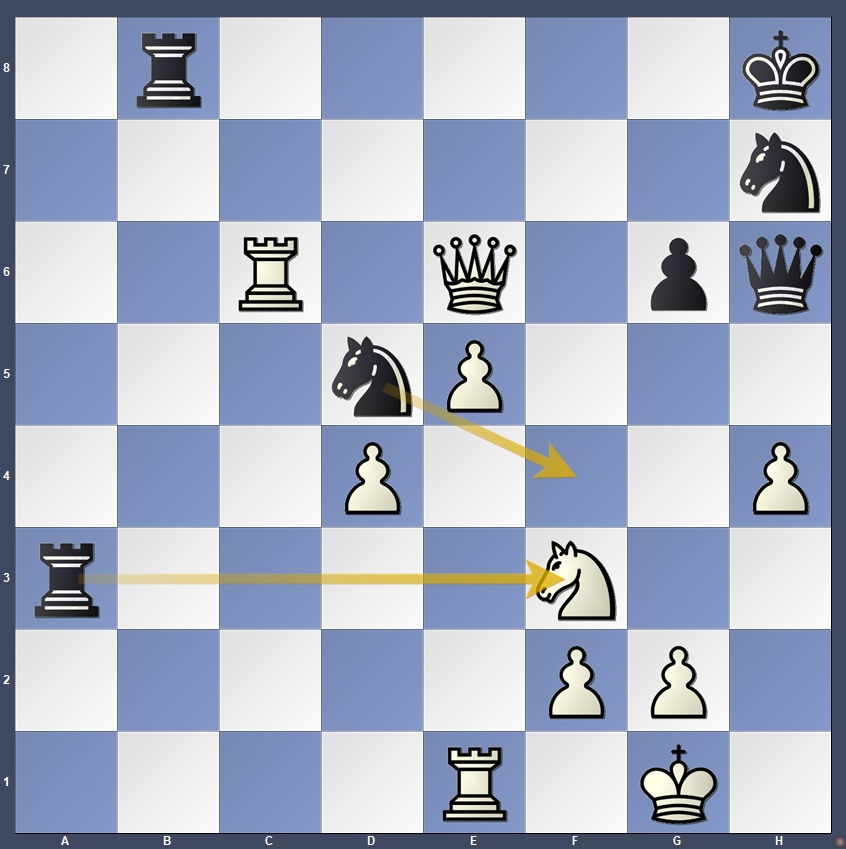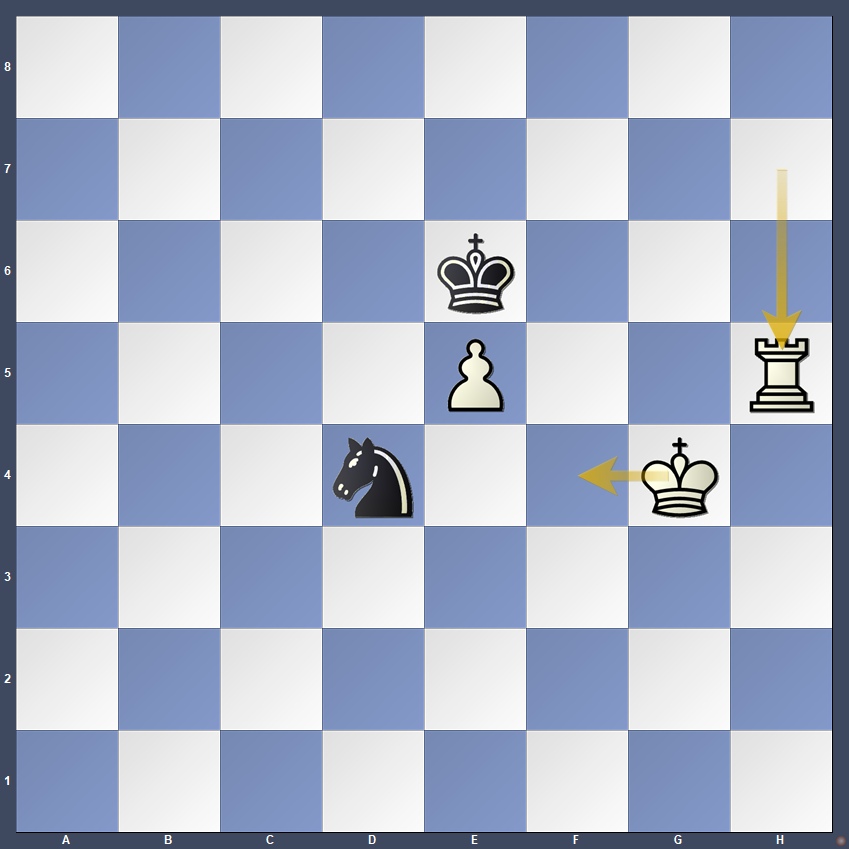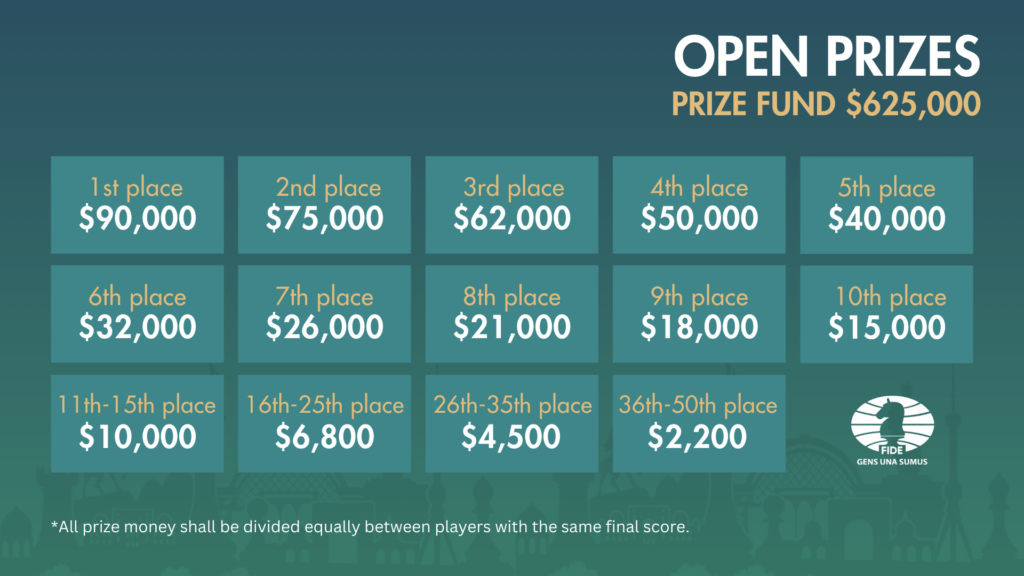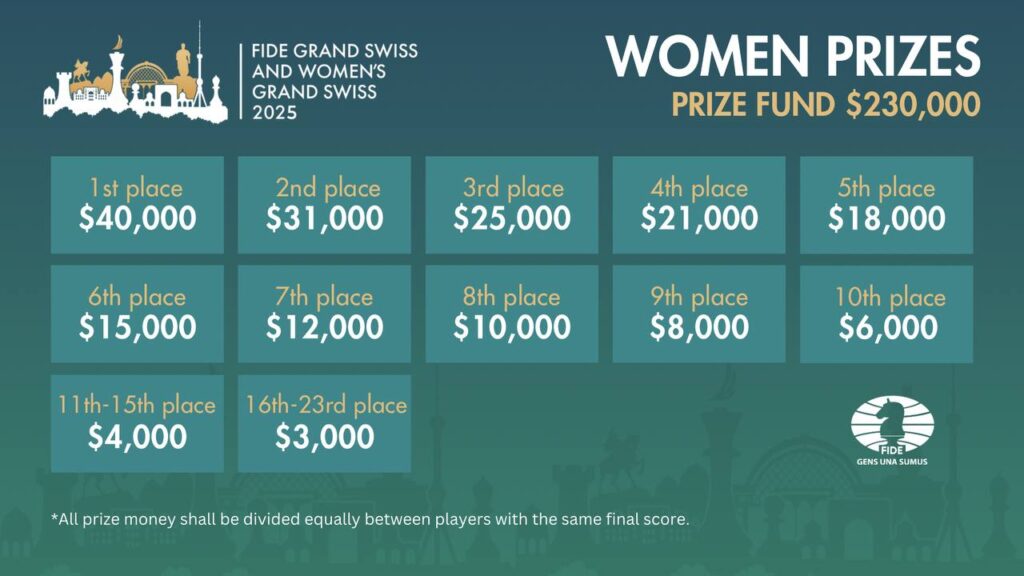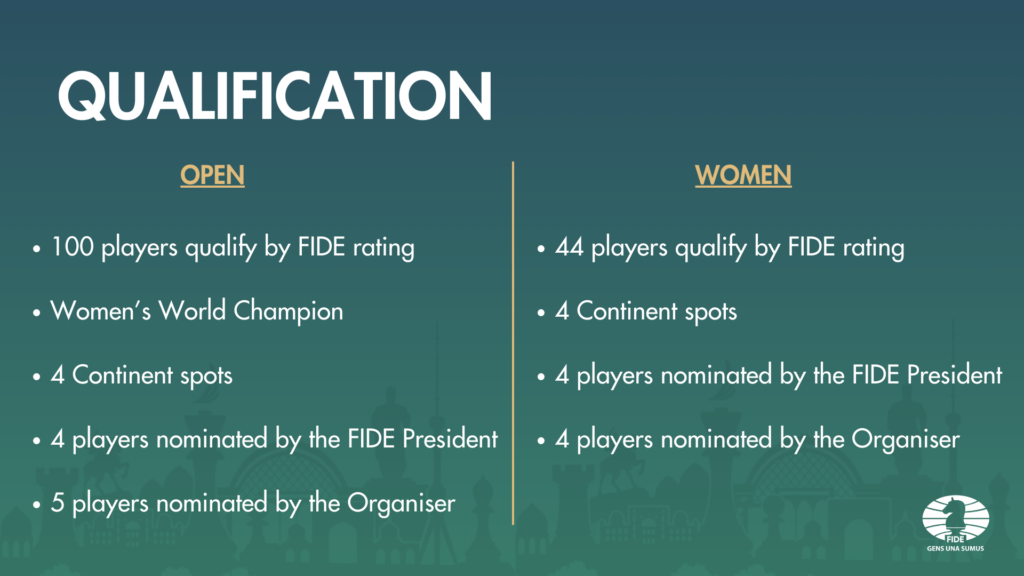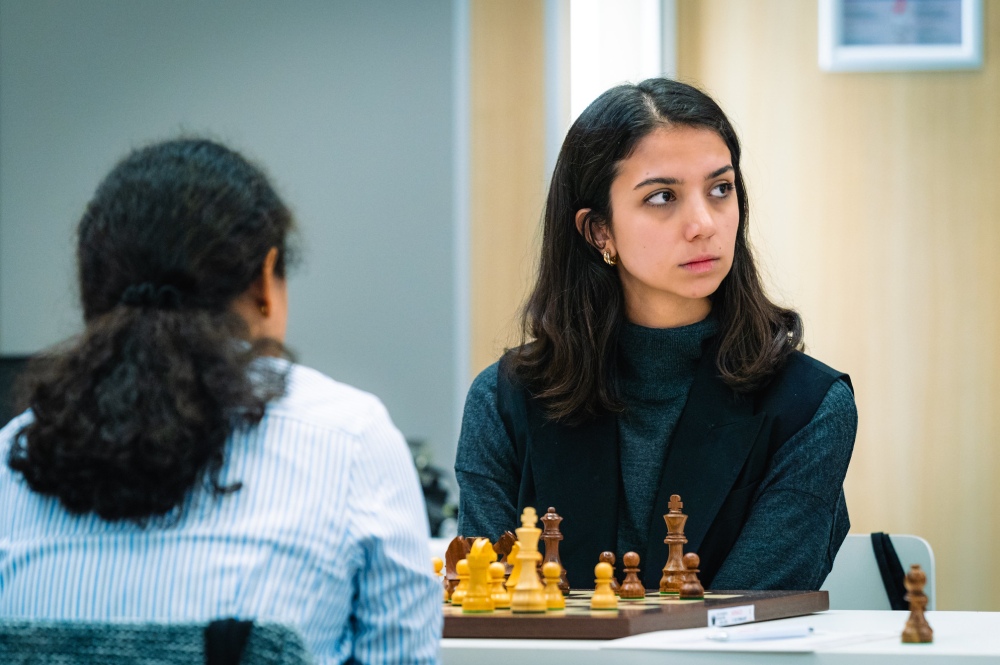
The seventh round of the FIDE Women’s Grand Prix delivered a mix of unexpected turns, missed chances, and a heartbreaking moment for Sara Khadem. While four games ended in draws, the biggest shock came in Khadem’s game against Humpy Koneru, where Khadem resigned in a drawn position—an agonizing outcome after five and a half hours of play.
As the tournament nears its climax, the competition is intensifying. Kateryna Lagno has held the lead for several rounds, but today’s results have shaken up the standings, making it anyone’s game. Humpy Koneru’s win propelled her to joint second place alongside Aleksandra Goryachkina and Batkhuyag Munguntuul, setting the stage for an unpredictable finish.
The day began with a special visit from three basketball players from the Monaco Basketball Association, who made the ceremonial first move. In a show of support for women’s sports, they exchanged one of their team jerseys for a specially designed shirt from the FIDE Women’s Commission. Also in attendance for the ceremonial first move was Inna Bazhenova, founder of TAEX who is a key sponsor in this event.
Round 7 results:
Elisabeth Paehtz 1/2-1/2 Aleksandra Goryachkina
Batkhuyag Munguntuul 1/2-1/2 Harika Dronavalli
Alexandra Kosteniuk 1/2-1/2 Bibisara Assaubayeva
Zhongyi Tan 1/2-1/2 Kateryna Lagno
Humpy Koneru 1-0 Sarasadat Khademalsharieh
Elisabeth Paehtz – Aleksandra Goryachkina
The first game to conclude was between Paehtz and Goryachkina, lasting just 30 minutes. A threefold repetition was reached by move 13—a curious decision by Goryachkina, given that she trails Lagno by just half a point.
Whether it was a strategic choice to conserve energy remains unclear.
Batkhuyag Munguntuul – Harika Dronavalli
Munguntuul has had a strong tournament so far, winning her first game against Kosteniuk and then drawing the rest – escaping in some, and not converting advantages in others, but always demonstrating tenacity and often surprising her opponents. On the other hand, Dronavalli’s event so far has been the opposite making this game not just dependent on skill but also the opponnents’ mental states. Both players were overly cautious, spending a lot of time on their moves – even 20 minutes at some point.
White attained a promising position out of a Sicilian Kalashnikov but misplayed on the queenside giving Black a chance to fight for more than just a draw. But Dronavalli understandably remained solid, forcing multiple trades leading to an equal position. Eventually, the game was drawn by a three-fold repetition. For Harika, this result with black pieces is not bad, particularly when it is easy for a player to lose objectivity whilst struggling in an event.
Alexandra Kosteniuk – Bibisara Assaubayeva
Assaubayeva, leading the overall Grand Prix standings, has not been in her best form in this event, missing opportunities in games which she normally would not have (as she did in her game yesterday). But today her play can be characterized as more passive than usual where White got an early advantage out of a King’s Indian Defense, an opening in which Black could either get an active play or enter something boring, requiring accuracy in defense.
Assaubayeva, seeming visibly unenthused in the game (likely due to the nature of the position as well as her ill health), found herself in a tough situation. Luckily for her Kosteniuk did not find the best continuation and ended up in “only” in a better position.
Soon the opponents liquidated into an endgame, both sides had the bishop pair and a rook, and five pawns. But White’s pieces were much more active, with her rook on an open file, and a better pawn structure given Black’s isolated e-pawn. After Bibisara’s impetous h7-h5 push on move 29, engines’ evaluation bar indicated White’s decisive advantage.
However, it was important for White to take a steady approach and bring the king out with 31.Kf2, which is always useful in the endgame. Perhaps afraid of 31…h4 by Black (to which White can react with 32.Kf3 followed by either Kg4 or Ke4), she played the natural 31.g4? dropping a lion share of her advantage. Black’s best response was to ignore the pawn and bring the rook back into the game with 31…Rd8. But instead, she did capture 31…hxg4, and Kosteniuk responded quickly with the incorrect 32.Bxg4? when capturing with the pawn made much more sense and would also have allowed the white rook activity on the h-file. In the game, White tried lunging the h-pawn forward, but Black was able to completely hold the position and take the game to an eventual draw.
Tan Zhongyi – Kateryna Lagno
The game to watch this round was most definitely between Tan and Lagno – considering that Lagno is currently leading the standings, and Tan seems to have gotten her mojo back after securing an impressive victory against Sara Khadem. In a version of the King’s Indian Defense, Lagno took the game out of main theory with 6…a5, but Tan, possibly well versed in the line, immediately responded with the accurate 7.0-0. This moment set the expectations for the high level of the game and the psychology too. After a couple of White’s inaccuracies (the Nd5-Ne3 maneuver looks strange) Black came out of the opening comfortably, and soon the opponents entered a very complicated queenless middlegame.
As the game progressed, White found herself in trouble and had to navigate the chaos with only 1 minute on her clock, compared to her opponent’s 14 minutes. In an excellent display of skill, Tan not only managed to equalize the position in the time scramble but suddenly turned the tables and got a chance took over the advantage.
Here Black should have simply captured the pawn on g5 with an equal position but instead Kateryna played 35…Bd4?? allowing 36.f4! with an absolutely wining position for White. Opposite colored bishops are known for drawish tendencies but in this particular case Black is hopeless as her queenside pawns are too weak.
But White missed a golden opportunity and erred with 36.Kd3? and after 36… Bxe5 37.c5 emerged with a superior but far from winning position. After the chaotic mess, the opponents reached time control, with an equal endgame appearing on the board. Though an exciting pawn race ensued, both sides played with extreme accuracy and after this exciting fight, the game was eventually drawn. It ended with a queen and bishop versus queen which White kept trying until the very end, hoping for an error by her opponent pushing the game to a nearly 6 hour battle. But with a beautiful end, Lagno found a nice stalemate tactic to finish things off.
Humpy Koneru – Sarasadat Khademalsharieh
Humpy came well-prepared in a sideline of the Queen’s Gambit Declined today with 1.d4 Nf6 2.c4 e6 3.Bg5. As commentator GM Alojzije Jankovic said; “these days everyone is playing everything”, and choosing such an opening in this elite event is a wise practical decision. White got a good position right out of the opening, which, paired with a hefty time advantage, put her in more control of the game. This was increased even more due to Black’s passive pieces and inability to open the position with a central pawn break.
White clearly outplayed Black in the opening, but converting the advantage was no easy task. Humpy started off by setting up a creative bishop and queen maneuver, forcing Black to weaken her kingside pawns. Although this did not offer any immediate advantage, it became important later when White launched a deadly attack on the black king.
White completely dominated the game, even though Black found interesting resources and defended well. By move 41 the opponents reached the following position :
Here White had many choices (41.Ne4 and 41.Rсc1 to name a few) but Humpy decided to go with the interesting piece sacrifice: 41.Nxe6 – not necessary, but one that was exciting and made sense given that White picked up many pawns. 41…fxe6 42.Qxe6+ Kh8 43.Rxc6
Now White is still clearly better and an interesting try for Black could have been 43…Rxf3 which would offer a practical chance. After 44.gxf3 Qxh4 45.Qxd5 Ng5 as analyzed by the commentators, White is faced with finding the only move 46.Rf6.
Nevertheless, in the game 43…Nf4 was played where 44.Qg4 would have held the kingside, and allowed White to start advancing pawns. Instead, White made the curious decision of trading off pieces with 44.Rc8+ and suddenly after 44…Rxc8 45.Qxc8 Qf8 46.Qxf8 the position became equal. From this point, the engine would sway multiple times between equality and winning for white. But it is the final sequence of events that is worth watching:
At this point, both players were playing with less than a minute on the clock. Black’s only chance to maintain equality was 70…Rxh7 but the erroneous 70…Ke6? was played instead, most likely scared of d5 coming from White.
71.f4! Immediately played by Humpy 71…Rxa7 72.f5 Nxf5 73.Rxh7 Nxd4 and the only move for White was 74.Kf4, defending the pawn with the king and allowing the white rook to move freely, completely winning as the pawn would eventually march forward.
Instead, in the most intense moment of the event so far, Humpy played 74.Rh5?? Which gave Black the chance to hold on draw with 74…Kd5! 75.Kf4 Ne6+. Strange as it may sound White can’t make progress despite being and exchange and a pawn up.
BUT Sara resigned! “What a scene” our commentators exclaimed as they witnessed this drama unfold after 5.5 hours of play. Black held on and fought for so long, finding only moves to stay afloat, and after all of that, gave up in a moment when she shouldn’t have. Many chess players can relate to this painful moment, and it will no doubt be a difficult thing for Sara to swallow, but that is life. Her fighting spirit throughout the game, despite yesterday’s loss, is admirable, and she has showcased her capability and place in the women’s elite.
Standings after Round 7:
Kateryna Lagno – 4.5
Batkhuyag Munguntuul – 4
Aleksandra Goryachkina – 4
Humpy Koneru – 4
Alexandra Kosteniuk – 3.5
Tan Zhongyi – 3.5
Sarasadat Khademalsharieh – 3
Elisabeth Paehtz – 3
Bibisara Assaubayeva – 3
Harika Dronavalli – 2.5
Round eight pairings and dates
The eighth round of the third leg in the 2024/25 Women’s Grand Prix series starts on Wednesday, February 26th at 15:00 CET local time in Monte-Carlo, Monaco.
Round 8 pairings:
Aleksandra Goryachkina – Sarasadat Khademalsharieh
Kateryna Lagno – Humpy Koneru
Bibisara Assaubayeva – Tan Zhongyi
Harika Dronavalli – Alexandra Kosteniuk
Elisabeth Paehtz – Batkhuyag Munguntuul
More information about the event, including the regulations and details of the pairings, as well as live games can be found on the official website: womengrandprix.fide.com.
You can follow the games live and watch the action with our wonderful commentators GM Alojzije Jankovic & IM Almira Skripchenko on YouTube.
Written by Charlize van Zyl
Photos: Niki Riga



